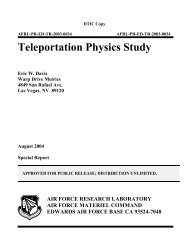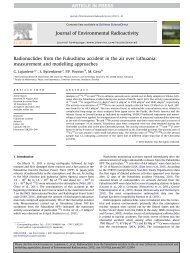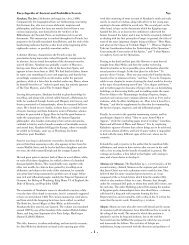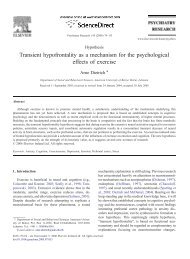New Crystal in the Pineal Gland: Characterization and Potential - URSI
New Crystal in the Pineal Gland: Characterization and Potential - URSI
New Crystal in the Pineal Gland: Characterization and Potential - URSI
Create successful ePaper yourself
Turn your PDF publications into a flip-book with our unique Google optimized e-Paper software.
<strong>New</strong> <strong>Crystal</strong> <strong>in</strong> <strong>the</strong> P<strong>in</strong>eal <strong>Gl<strong>and</strong></strong>:<br />
<strong>Characterization</strong> <strong>and</strong> <strong>Potential</strong> Role <strong>in</strong> Electromechano-Transduction<br />
Baconnier Simon (1) , Lang Sidney B. (2) , De Seze Rene (3)<br />
(1) DRC, Toxicologie Expérimentale, INERIS, 60550 Verneuil-en-Halatte, France. E-mail : simon.baconnieretudiant@<strong>in</strong>eris.fr<br />
(2) Department of Chemical Eng<strong>in</strong>eer<strong>in</strong>g, Ben-Gurion University of <strong>the</strong> Negev, 84105 Beer Sheva, Israel. E-mail :<br />
lang@bgumail.bgu.ac.il<br />
(3) As (1) above, but E-mail : Rene.De-Seze@<strong>in</strong>eris.fr<br />
ABSTRACT<br />
The p<strong>in</strong>eal gl<strong>and</strong> is a neuroendocr<strong>in</strong>e transducer secret<strong>in</strong>g melaton<strong>in</strong>, responsible for <strong>the</strong> physiological circadian rhythm<br />
control. A new form of biom<strong>in</strong>eralization has been studied <strong>in</strong> <strong>the</strong> human p<strong>in</strong>eal gl<strong>and</strong>. It consists of small crystals that<br />
are less than 20 µm <strong>in</strong> length. These crystals could be responsible for an electromechanical biological transduction<br />
mechanism <strong>in</strong> <strong>the</strong> p<strong>in</strong>eal gl<strong>and</strong> due to <strong>the</strong>ir structure <strong>and</strong> piezoelectric properties.<br />
Us<strong>in</strong>g scann<strong>in</strong>g electron microscopy (SEM) <strong>and</strong> energy dispersive spectroscopy (EDS), we identified crystals<br />
morphology <strong>and</strong> showed that <strong>the</strong>y only conta<strong>in</strong> calcium, carbon <strong>and</strong> oxygen elements. Fur<strong>the</strong>rmore, <strong>the</strong> selected-area<br />
electron diffraction (SAED) <strong>and</strong> near-<strong>in</strong>frared Raman spectroscopy established that <strong>the</strong> crystals are calcite.<br />
We will now focus on <strong>the</strong> physiological effect of microcrystals <strong>in</strong> p<strong>in</strong>ealocyte cell culture under Radio-Frequency<br />
Electromagnetic-Fields (RF-EMF).<br />
INTRODUCTION<br />
Because of <strong>the</strong> fast development of mobile telecommunication, <strong>the</strong> <strong>in</strong>teraction of Electromagnetic Fields<br />
(EMF) with biological environment becomes a public health concern. Although <strong>the</strong> action of non-ioniz<strong>in</strong>g radiation on<br />
biology is still unclear, several hypo<strong>the</strong>ses of <strong>in</strong>teraction have been suggested: hot spot phenomena, ADN/RF-EMF<br />
<strong>in</strong>teraction, EMF effect on cellular development (oncology) [1-3]. But no conv<strong>in</strong>c<strong>in</strong>g study br<strong>in</strong>gs to <strong>the</strong> conclusion of<br />
an effective risk of RF-EMF for health.<br />
The p<strong>in</strong>eal gl<strong>and</strong> converts a neural signal <strong>in</strong>to an endocr<strong>in</strong>e output. The most important hormone it secretes is melaton<strong>in</strong><br />
<strong>the</strong> ma<strong>in</strong> role of which is to control <strong>the</strong> physiological circadian rhythm [4].<br />
Two biom<strong>in</strong>eralization forms can be observed <strong>in</strong> <strong>the</strong> p<strong>in</strong>eal gl<strong>and</strong>. Concretions so called “bra<strong>in</strong> s<strong>and</strong>”, a polycrystall<strong>in</strong>e<br />
complex of few millimeters long, <strong>and</strong> microcrystals <strong>the</strong> length of which does not exceed 20 micrometers. While<br />
concretions have been extensively studied [5-9] no study has been published on <strong>the</strong> microcrystals.<br />
In this article <strong>the</strong> microcrystals were analyzed with different biophysical techniques. Their physicochemical properties<br />
<strong>and</strong> particularly piezoelectricity would give <strong>the</strong>m an active role <strong>in</strong> a potential mechanism of electromechanotransduction<br />
<strong>in</strong> <strong>the</strong> p<strong>in</strong>eal body. We are currently plann<strong>in</strong>g a study on <strong>the</strong> effects of Global System for Mobile (GSM)<br />
waves on <strong>the</strong>se microcrystals <strong>in</strong> cellular culture <strong>and</strong> <strong>the</strong>ir <strong>in</strong>fluence on <strong>the</strong> p<strong>in</strong>eal body physiology.<br />
MATERIALS AND METHODS<br />
The microcrystals were isolated from <strong>the</strong> p<strong>in</strong>eal bodies us<strong>in</strong>g a procedure developed by We<strong>in</strong>er <strong>and</strong> Price [10].<br />
Small pieces of <strong>the</strong> p<strong>in</strong>eal body (about 10 mg) were placed <strong>in</strong> a micro-centrifuge tube conta<strong>in</strong><strong>in</strong>g 1.5 ml of 2.5% sodium<br />
hypochlorite (diluted commercial bleach) <strong>and</strong> sonicated for 20 m<strong>in</strong>utes. After allow<strong>in</strong>g <strong>the</strong> sample to settle for 1 m<strong>in</strong>ute,<br />
<strong>the</strong> supernatant liquid was transferred to a second micro-centrifuge tube <strong>and</strong> centrifuged at approximately 9000 g for 1<br />
m<strong>in</strong>ute. The pellet conta<strong>in</strong><strong>in</strong>g <strong>the</strong> solids was immediately washed twice with 95% ethanol <strong>and</strong> <strong>the</strong>n resuspended <strong>in</strong><br />
approximately 50 µl of 100% ethanol. It should be emphasized that, at no po<strong>in</strong>t, did any of <strong>the</strong> samples come <strong>in</strong>to<br />
contact with solutions conta<strong>in</strong><strong>in</strong>g calcium ions. SEM samples were collected on transmission electron microscopy grids<br />
<strong>and</strong> analyzed with a JEOL JSM 5600 SEM. Microanalysis studies were performed with a NORAN EDS Analyz<strong>in</strong>g<br />
System. Because <strong>the</strong> microcrystals were <strong>in</strong>itially too thick for High Resolution Transmission Electron Microscopy<br />
1
(HRTEM) observation, <strong>the</strong>y were first crushed between two glass slides. They were <strong>the</strong>n studied with a JEOL-2010<br />
transmission electron microscope equipped with an analytical ISIS system for energy dispersive X-ray spectroscopy<br />
(EDS). Near <strong>in</strong>frared Raman spectra of isolated crystals <strong>and</strong> pure calcite were obta<strong>in</strong>ed with a Bruker IFS 66 FTIR<br />
spectrometer equipped with an FRA 106 Raman module <strong>and</strong> a Ramanscope microscope. Measurements were made with<br />
a 40X objective (spot size ~25 µm). The spectral resolution was 2 cm -1 . The samples were excited at 1064 nm us<strong>in</strong>g a<br />
diode-pumped Nd:YAG laser at about 5 mW power. Second Harmonic Generation (SHG) studies were made with a<br />
Nd-YAG laser which produced radiation at 1064 nm <strong>and</strong> <strong>the</strong> detected SHG was at 532 nm.<br />
RESULTS AND DISCUSSION<br />
The SEM studies of s<strong>in</strong>gle microcrystals permitted high-quality morphological analysis. The most common<br />
morphology was a very rough cyl<strong>in</strong>drical body with sharp extremities (Fig. 1) that comprised about 95% of <strong>the</strong> samples<br />
observed. The crystal size varied from 1 to about 20 µm. The EDS analyzer coupled to <strong>the</strong> SEM identified calcium,<br />
carbon <strong>and</strong> oxygen to be <strong>the</strong> pr<strong>in</strong>cipal elements. Among biom<strong>in</strong>erals conta<strong>in</strong><strong>in</strong>g those atoms, only calcium carbonate<br />
<strong>and</strong> calcium oxalate are potential c<strong>and</strong>idates. The electron diffraction patterns taken from <strong>the</strong> particles were <strong>in</strong>dexed <strong>in</strong><br />
terms of a hexagonal unit cell. Near IR Raman spectra were measured on both <strong>the</strong> microcrystals <strong>and</strong> on pure calcite<br />
powder. The agreement of <strong>the</strong> peaks was excellent (Fig. 2), confirm<strong>in</strong>g <strong>the</strong> identification of <strong>the</strong> crystals as calcite<br />
(calcium carbonate). We were unable to detect SHG nei<strong>the</strong>r <strong>in</strong> pure hydroxyapatite powder nor <strong>in</strong> <strong>the</strong> large p<strong>in</strong>eal<br />
concretions. The similarity of <strong>the</strong> <strong>in</strong>tensity of <strong>the</strong> SHG <strong>in</strong> pure calcite to that observed <strong>in</strong> earlier work on p<strong>in</strong>eal tissue<br />
samples [11] <strong>and</strong> <strong>the</strong> absence of SHG <strong>in</strong> <strong>the</strong> large concretions let us th<strong>in</strong>k <strong>the</strong> calcite microcrystals would be <strong>the</strong> source<br />
of <strong>the</strong> SHG <strong>in</strong> <strong>the</strong> previous observation.<br />
The p<strong>in</strong>eal microcrystals appear as a stack of th<strong>in</strong> rhombohedrons with <strong>the</strong>ir flat faces normal to <strong>the</strong> long axis<br />
of <strong>the</strong> crystal (Fig. 3). These complex structures can be classified us<strong>in</strong>g <strong>the</strong> texture po<strong>in</strong>t group nomenclature of<br />
Shubnikov et al. [12]. The texture may be noncentrosymmetric because of <strong>the</strong> structural organization of <strong>the</strong> sub-unit,<br />
even though <strong>the</strong> s<strong>in</strong>gle crystals do have a center of symmetry. This symmetry break<strong>in</strong>g would allow both SHG <strong>and</strong><br />
piezoelectricity.<br />
Calcite <strong>in</strong> otoconia, microcrystals found <strong>in</strong> <strong>the</strong> <strong>in</strong>ner-ear otolith, has been shown to exhibit piezoelectricity [13, 14].<br />
These crystals have a structure similar to that of <strong>the</strong> p<strong>in</strong>eal microcrystals.<br />
By that very fact <strong>the</strong> piezoelectric property of <strong>the</strong> crystals would allow <strong>the</strong>m to <strong>in</strong>teract with <strong>the</strong> electrical component of<br />
electromagnetic fields. A simplified formula applied to those crystals (f = v/2d) lets us th<strong>in</strong>k that <strong>the</strong>se crystals could be<br />
sensitive to RF-EMF <strong>in</strong> <strong>the</strong> range of 500MHz to 2.5GHz depend<strong>in</strong>g on <strong>the</strong>re size. This range conta<strong>in</strong>s portable wireless<br />
frequencies, GSM (872-960MHz), DCS (1710-1875MHz), UMTS (1900-1920MHz, 2010-2025MHz), or BlueTooth<br />
(2400-2483,5MHz). Piezoelectric determ<strong>in</strong>ation of m<strong>in</strong>ute gra<strong>in</strong> requires develop<strong>in</strong>g new methods based on ei<strong>the</strong>r<br />
MEMS Precision Instruments microtweezers or direct correlation between electro-optic <strong>and</strong> piezoelectric properties <strong>in</strong><br />
crystal with optical microscopy.<br />
We <strong>in</strong>troduce a novel approach of <strong>the</strong> biophysical effects of weak microwave radiation.<br />
CONCLUSION AND PERSPECTIVES<br />
We report here <strong>the</strong> presence of a new form of m<strong>in</strong>eral deposits <strong>in</strong> <strong>the</strong> p<strong>in</strong>eal gl<strong>and</strong>. The calcite microcrystals<br />
would have piezoelectric properties with excitability <strong>in</strong> <strong>the</strong> frequency range of mobile communications. Their<br />
<strong>in</strong>teraction with GSM waves could constitute a new mechanism of electromecano-transduction on <strong>the</strong> p<strong>in</strong>ealocyte<br />
membrane, <strong>in</strong>fluenc<strong>in</strong>g by <strong>the</strong> fact <strong>the</strong> melaton<strong>in</strong> production.<br />
The RF-EMF electrical component <strong>in</strong>teraction with <strong>the</strong> crystals could <strong>in</strong>duce a morphological modification of <strong>the</strong><br />
crystals, a vibration depend<strong>in</strong>g on <strong>the</strong> EMF frequency. This morphological change, even t<strong>in</strong>y, could <strong>in</strong>volve a<br />
modification of <strong>the</strong>ir cellular environment, by a localized modification of <strong>the</strong> cellular membrane of related cells.<br />
The membrane changes could alter <strong>the</strong> adrenergic suggested <strong>and</strong>/or calcium channel function.<br />
A similar mechanism of magneto-transduction was revealed by Kirschv<strong>in</strong>k <strong>in</strong> connection with magnetite crystals of <strong>the</strong><br />
bra<strong>in</strong> <strong>and</strong> <strong>the</strong>ir <strong>in</strong>teraction with <strong>the</strong> magnetic component of RF-EMF [15].<br />
P<strong>in</strong>ealocyte can "communicate" through <strong>the</strong>ir gap junction [16, 17]. The deformation caused by <strong>the</strong> crystal vibrations<br />
could thus by simple activation of one or two p<strong>in</strong>ealocytes, activate a whole area of p<strong>in</strong>eal cells <strong>and</strong> <strong>the</strong>reby act on <strong>the</strong><br />
p<strong>in</strong>eal physiology.<br />
The scientific project to be developed is to determ<strong>in</strong>e <strong>the</strong> <strong>in</strong>fluence of RF-EMF GSM on p<strong>in</strong>ealocyte <strong>and</strong> p<strong>in</strong>eal<br />
gl<strong>and</strong> physiology through <strong>the</strong> electromechano-transduction produce by <strong>the</strong> p<strong>in</strong>eal microcrystals. Us<strong>in</strong>g ELISA tests <strong>and</strong><br />
Laser Scann<strong>in</strong>g Confocal Microscopy we are go<strong>in</strong>g to study <strong>the</strong> evolution <strong>in</strong> melaton<strong>in</strong> production <strong>and</strong> variation <strong>in</strong> cell<br />
calcium flux <strong>in</strong> primary p<strong>in</strong>eal cell culture.<br />
2
REFERENCES<br />
[1] R. Adey, "Bioeffects of mobile communications fields; possible mechanisms for cumulative dose," <strong>in</strong> Mobile<br />
Communication Safety, N. B. Kuster, Q.; L<strong>in</strong>, J.C., Ed. <strong>New</strong> York: Chapman <strong>and</strong> Hall, 1996, pp. 103-132.<br />
[2] A. Maes, M. Collier, D. Slaets <strong>and</strong> L. Verschaeve, "954 MHz microwaves enhance <strong>the</strong> mutagenic properties of<br />
mytomyc<strong>in</strong>C," Environ Mol Mutagen, vol. 28, pp. 26-30, 1996.<br />
[3] R. B. Stagg, "DNA Syn<strong>the</strong>sis <strong>and</strong> cell proliferation <strong>in</strong> C6 glioma <strong>and</strong> primary glial cells exposed to a<br />
836.55MHz modulated radiofrequency field," Bioelectromagnetics, vol. 18, pp. 230-236, 1997.<br />
[4] M. Karasek, "Melaton<strong>in</strong> <strong>in</strong> humans - where we are 40 years after its discovery," Neuroendocr<strong>in</strong>ology Letters,<br />
vol. 20, pp. 179-188, 1999.<br />
[5] G. Bocchi <strong>and</strong> G. Valdre, "Physical, chemical <strong>and</strong> m<strong>in</strong>eralogical characterization of carbonate-hydroxyapatite<br />
concretions of <strong>the</strong> human p<strong>in</strong>eal gl<strong>and</strong>.," Journal of Inorganic Biochemistry, vol. 49, pp. 209-220, 1993.<br />
[6] I. Galliani, F. Frank, P. Gobbi, F. Giangaspero, <strong>and</strong> E. Falcieri, "Histochemichal <strong>and</strong> ultrastructural study of<br />
<strong>the</strong> human p<strong>in</strong>eal gl<strong>and</strong> <strong>in</strong> <strong>the</strong> course of ag<strong>in</strong>g.," Journal of Submicroscopic Cytology <strong>and</strong> Pathology, vol. 21,<br />
pp. 571-578, 1989.<br />
[7] J. L. Japha, T. J. Eder, <strong>and</strong> E. D. Goldsmith, "Calcified <strong>in</strong>clusions <strong>in</strong> <strong>the</strong> superficial p<strong>in</strong>eal gl<strong>and</strong> of <strong>the</strong><br />
Mongolian gerbil, Meriones unguiculatus," Acta Anatomica, vol. 94, pp. 533-544, 1976.<br />
[8] T. Kodaka, R. Mori, K. Debari, <strong>and</strong> M. Yamada, "Scann<strong>in</strong>g electron microscopy <strong>and</strong> electron probe<br />
microanalysis studies of human p<strong>in</strong>eal concretions," Journal of Electronic Microscopy, vol. 43, pp. 307-317,<br />
1994.<br />
[9] R. Krstic <strong>and</strong> J. Golaz, "Ultrastructural <strong>and</strong> X-ray microprobe comparison of gerbil <strong>and</strong> human p<strong>in</strong>eal<br />
acervuli.,",, pp. 507-578, 1976.<br />
[10] S. We<strong>in</strong>er <strong>and</strong> P. A. Price, "Disaggregation of bone <strong>in</strong>to crystals.," Calcified Tissue International, vol. 39, pp.<br />
365-375, 1986.<br />
[11] S. Lang, B., A. Mar<strong>in</strong>o, A., G. Berkovic, M. Fowler, <strong>and</strong> K. Abreo, D., "Piezoelectricity <strong>in</strong> <strong>the</strong> human p<strong>in</strong>eal<br />
gl<strong>and</strong>.," Bioelectrochemistry <strong>and</strong> Bioenergetics, vol. 41, pp. 191-195, 1996.<br />
[12] A. V. Shubnikov, I. S. Zheludev, V. P. Konstant<strong>in</strong>ova, <strong>and</strong> I. M. Silvestrova, Etudes des textures<br />
piezoelectriques, Dunod ed. Paris, 1958.<br />
[13] M. D. Ross <strong>and</strong> K. G. Pote, "Some properties of otoconia," Phil. Trans. R. Soc. Lond. B, vol. 304, pp. 445-452,<br />
1984.<br />
[14] W. R. Morris <strong>and</strong> L. R. Kittleman, "Piezoelectric property of otoliths," Science, vol. 19, pp. 368-370, 1967.<br />
[15] J. Kirschv<strong>in</strong>k, "Microwave absorption by magnetite: a possible mechanism for coupl<strong>in</strong>g non<strong>the</strong>rmal levels of<br />
radiation to biological systems," Bioelectromagnetics, vol. 17, pp. 187-194, 1996.<br />
[16] M. Moller, "The ultrastructure of <strong>the</strong> human fetal p<strong>in</strong>eal gl<strong>and</strong>. I. Cell types <strong>and</strong> blood vessels," Cell <strong>and</strong><br />
Tissue Research, vol. 152, pp. 13-30, 1976.<br />
[17] J. Saez, V. Berthoud, R. Kadle, O. Traub, B. Nicholson, M. Bennett, <strong>and</strong> R. Dermietzel, "P<strong>in</strong>ealocytes <strong>in</strong> rats:<br />
connex<strong>in</strong> identificatioon <strong>and</strong> <strong>in</strong>crease <strong>in</strong> coupl<strong>in</strong>g caused by norep<strong>in</strong>ephr<strong>in</strong>e," Bra<strong>in</strong> Research, vol. 568, pp.<br />
265-275, 1991.<br />
FIGURES<br />
0,12<br />
microcrystal<br />
CaCO 3 (powder, Merck, pure for analysis)<br />
0,12<br />
0,10<br />
Raman<br />
Intensity<br />
0,08<br />
0,10<br />
0,08<br />
0,06<br />
0,06<br />
0,04<br />
Fig. 1: SEM picture of isolated crystal on a formvar -<br />
covered TEM grid<br />
1000<br />
Wavenumber [cm -1 ]<br />
Fig. 2: Raman spectra of p<strong>in</strong>eal gl<strong>and</strong> microcrystal <strong>and</strong><br />
pure calcite powder.<br />
0,04<br />
3
Fig. 3: SEM picture of isolated microcrystal on a Formvar-covered TEM grid. Notice <strong>the</strong> multilayered structure <strong>and</strong><br />
sharpen extremities. Sketch of two (:m)T type texture, with or without rotation.<br />
4














